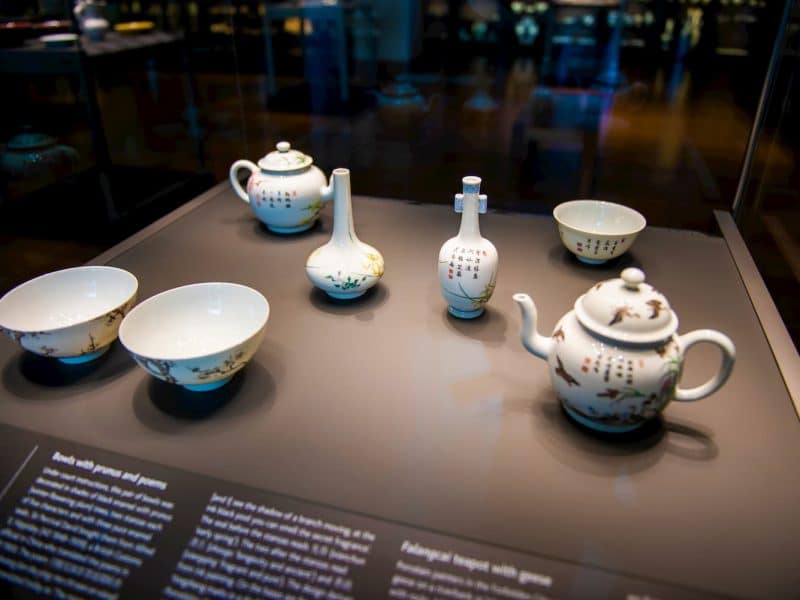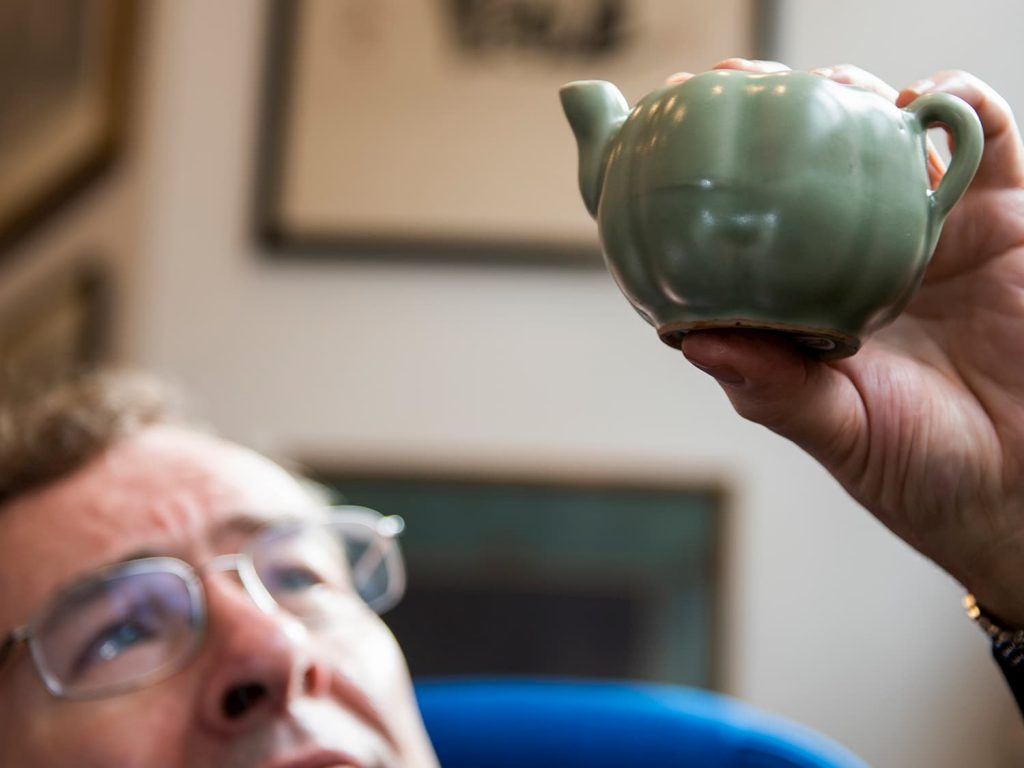Images: Giulio Mazzarini
Despite originating in China, porcelain teaware remains inextricably entwined with British culture. Colin Sheaf, Chairman of the Sir Percival David foundation of Chinese art, and deputy Chairman at Bonhams auction house, is a world-renowned expert in Asian art, including teaware. Here he explains how, without the physical accessories of Chinese teaware, tea may never have become Britain’s national drink.
—
The date is 25 September 1660. Famed diarist and chronicler of his age Samuel Pepys is sampling a new beverage for the first time. “And afterwards I did send for a cup of tee (a China drink) of which I never had drank before, and went away.”
Little did he know this “China drink” would become synonymous with British culture for centuries to come, bringing with it into popular culture one of the world’s most enduring products. A technically sophisticated product Chinese potters had been using to make and serve tea in for centuries. And that would prove to be fundamental in transforming ‘Camellia Sinensis’ from an exotic rarity into a ubiquitous cultural icon. That product was porcelain.
A Perfect Storm: The Introduction of Tea and Porcelain
Tea first arrived in Europe in the early 17th century, imported by the Dutch East India Company which had a monopoly of trade with Asia. The first mention of tea bowls coming to Europe was in the Company shipping lists for 1624. It wasn’t until half a century later than tea was popularised in Britain by King Charles II’s Portuguese wife Catherine of Braganza, atea lover since childhood. So much so, she brought a chest of tea with her as an extravagant part of her dowry.
Catherine’s influence introduced tea drinking to the English royal court. It was an immensely chic and recherché way for ladies to entertain each other grandly, without resorting to alcohol. In this socially-competitive environment, Catherine’s endorsement sparked a trend among the aristocracy, much like a celebrity endorsement might today.
Simultaneously, the Dutch were shipping back a novel type of accessory for drinking tea from their Asian headquarters in Java, to their huge wholesale annual auctions in the Netherlands. This was made using an elegant, translucent and highly decorative material by the name of porcelain which was quite unlike anything Western potters could produce.
The combination of the novel, practical attributes of tea as a caffeinated, non-alcoholic and refined beverage, with the arrival of porcelain teaware accessories from China, created the ‘perfect storm’ of desire. The kind that marketers today dream about.
Transforming Societal Norms: The Rise of Tea Drinking
The rise of tea and teaware helped to open up social occasions for women, creating a new dynamic. The arrival of three new, non-alcoholic – but caffeine-rich – beverages (tea, coffee and ‘breakfast chocolate’) played an amazing role in helping emancipate women from traditional roles, enhancing their independent social status.
During the 17th century, the format for entertaining was changing. The British aristocracy was building Palladian mansions that were designed internally for more refined social behaviour than traditional pre-Restoration baronial halls had permitted. While the men would drink and talk in the dining room and public rooms, often women would often now retire to the “withdrawing room”, (what we’d now call a “drawing room”), to drink tea. Sophisticated porcelain quickly became integral to these social occasions.
Teaware: a distinctive brand
Without having the accessories available to serve it attractively, tea may never have taken off as it did. Until then, most drinking receptacles – thick, clunky pots like Dutch Delft or lumpy stonewares – were more akin to a mug for builder’s tea than something you’d expect in high society.
Delightful porcelain was not only a pleasure to use, but it also gave tea a recognisable brand, leading to enormous cultural cachet. It served as a visually distinctive vehicle to ignite people’s desires for this chic and enjoyable beverage.
Have It Your Way: The History of Tea Sets
By the early 1700s, when Queen Anne took to the throne, Chinese and Japanese porcelain was well-established in smart interiors, with rich families furnishing their houses with extravagant dinner services (“setts”), often comprising hundreds of pieces. Less wealthy, but socially-ambitious, nouveau-riche families, who couldn’t (yet) afford a gold or silver dinner service, would have their family coat-of-arms painted onto a porcelain service while it was being made in China.
These personalised dinner services and tea sets became a status symbol for successful British families, with some 10,000 estimated to have been made during the 18th century.
A typical tea set would include, among other things, airtight jars (‘caddies’) for storing the leaf tea; twelve each of tea bowls and coffee cups and saucers; a teapot and little stand; a coffee pot; a milk jug; a sugar bowl ‘slop’ basin; and often a small spoon-tray. All elegantly standing on a handsome silver tea tray, ready for the ‘lady of the house’ to skilfully dispense.
Cementing its status, William III’s wife Queen Mary was herself an avid collector of Chinese and Japanese porcelain. An inventory from 1697 suggests she had nearly 800 pieces spread throughout nine rooms, a few of which have amazingly survived to this day.
Entering the Mainstream: Porcelain Teaware
With both tea and porcelain usage spreading through society like wildfire, it was only a matter of time before it entered the mainstream. In fact, British-made ceramics from Staffordshire were one of the earliest success stories of the industrial revolution at the end of the 18th century. The English pots were deliberately not quite as fine as those made in China, because many were decorated by using printed designs unlike Chinese hand-painted ones, but it did make these local ceramics more accessible to the middle classes.
Queen’s Ware, which was invented by Josiah Wedgwood in the 1780s, was a refined ceramic material that was easy and fast to mass produce. This ultimately turned teaware into a low-cost, high-volume business. Teaware had entered the mainstream, bringing tea culture to a much wider audience.
The End of an Era: Changes in Porcelain Trade
The advent of the Napoleonic Wars at the start of the 19th century precipitated the end of the golden age of Chinese export porcelain coming to Britain. While Britain imported many craft products like silk and porcelain, and commodities like tea and pepper, from China, it had little to offer in return, except for bar silver. Once that silver was needed to finance the war efforts against Napoleon, British shipping routes from Asia were disrupted, and the import of Chinese porcelain dried up.
By then however, the Staffordshire ceramics industry was well established and highly competitive, using many technical innovations like bone china (porcelain made using animal bone ash) which was a strong, cost-effective substitute.
Role Reversal: Modern Trends in Chinese Art
When I started working in the London art world in the 1970s, Chinese art was very out of fashion. Since then, happily, that trend has reversed dramatically, and all Chinese art – including ‘export-market’ art like porcelain Chinese teaware – is highly sought after. With pleasing symmetry, much of the porcelain that arrived in Britain hundreds of years ago from China is now going back to its country of origin at auctions in Bonhams.
Interestingly, Chinese industry is now working closely with (rather than competing against) the Staffordshire ceramics industry, to learn the current ‘tricks of their trade’. This is not just from an artistic point of view, but significantly also a technological one, because the ceramic body is increasingly recognised by engineers as having remarkable industrial properties such as low conductivity and high heat resistance.
History Repeating: The Enduring Legacy of Tea and Teaware
Without porcelain, tea may not have come to dominate the British ‘beverage landscape’ quite so quickly, or possibly at all. What’s fascinating is how elements of the original story of tea and teaware in Britain still resonate with the world today. How “celebrity” endorsement, covetable accessories and a stimulating product can combine to create a “brand” that transformed a simple commodity into a cultural icon with immense influence.
Click here to find out more about tea at Finlays.
—
Colin Sheaf is Group Head of Asian Art and Group Deputy Chairman at Bonhams. An Exhibitioner in Modern History at Worcester College, Oxford, he has enjoyed a distinguished 40-year auction-world career as an authority on Chinese Art, based variously in London, New York and Hong Kong. Currently he oversees Asian Art specialist teams on four continents, with departments holding sales in London, Hong Kong, New York, Los Angeles, San Francisco and Sydney. For further information about Chinese porcelain and the historical tea trade, contact Colin Sheaf at colin.sheaf@outlook.com.






